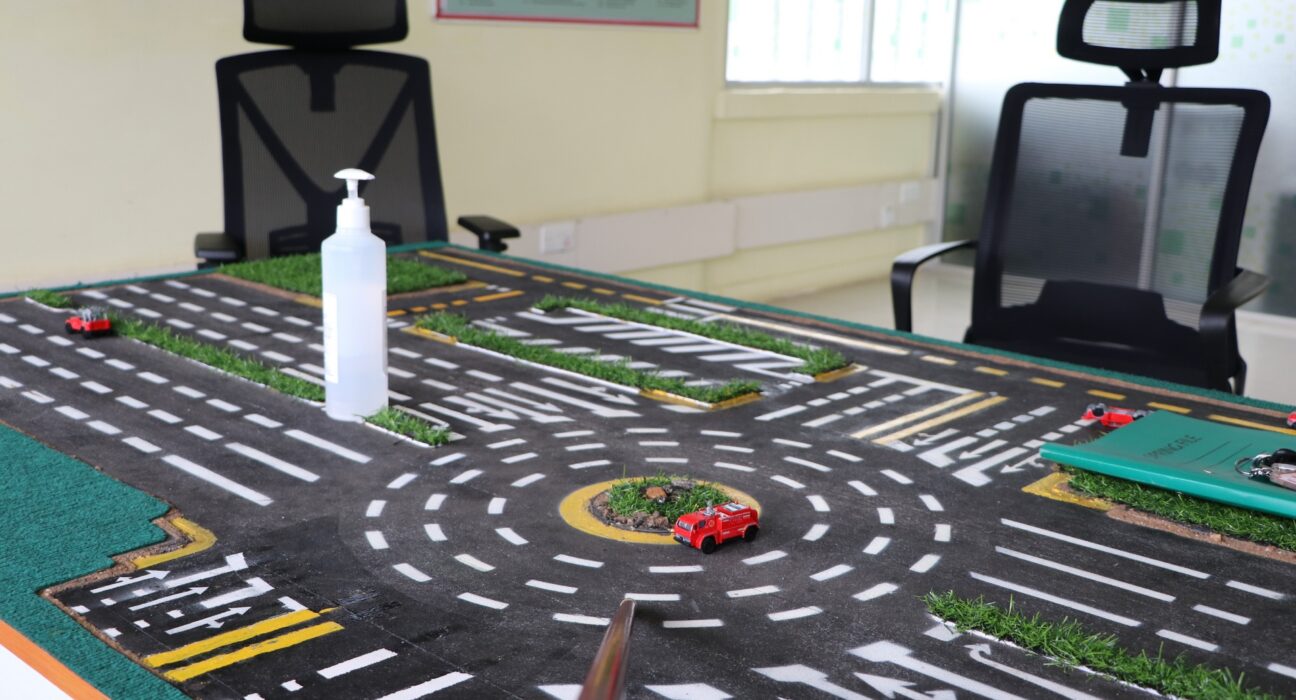If you’re preparing for your driving exam in Kenya, mastering 4 lane roundabouts is a must. These complex intersections, found in busy urban centers like Nairobi’s Globe Roundabout are designed to manage high traffic volumes while keeping roads safe. However, their multi-lane setup can be intimidating for new drivers. With the National Transport and Safety Authority (NTSA) emphasizing strict adherence to traffic rules in 2025, understanding the rules for 4 lane roundabouts in Kenya is critical to passing your driving test and driving safely.
What Is a 4 Lane Roundabout?
A 4 lane roundabout is a circular intersection with four lanes of traffic moving counterclockwise around a central island. Unlike smaller roundabouts, these are built to handle heavy traffic in Kenya’s growing cities. For your driving exam, examiners will test your ability to enter, circulate, and exit these roundabouts safely.
Key Features to Know
- Four Lanes: Multiple lanes allow several vehicles to move at once, making lane choice critical.
- Counterclockwise Flow: Traffic moves to the right, following Kenya’s right-hand driving system.
- Yield Rule: You must give way to vehicles already in the roundabout.
- Signage and Markings: Look for road signs and lane markings to guide your lane selection and exit.
Understanding these features is the first step to impressing your examiner and avoiding common mistakes.
Why 4 Lane Roundabouts Are Tested in Driving Exams
The NTSA includes 4 lane roundabouts in driving exams because they test a range of skills: observation, decision-making, lane discipline, and adherence to traffic rules. Kenya’s National Road Safety Action Plan 2024-2028 aims to reduce road accidents by 50% by 2030, and roundabouts play a big role in this by reducing collision points compared to traffic lights. For learners, mastering roundabouts shows you’re ready for real-world driving in busy urban areas.
Key Rules for 4 Lane Roundabouts in Kenya
To pass your driving exam, you need to follow the NTSA’s rules for navigating 4 lane roundabouts, outlined in the Traffic Act and reinforced by the Kenya Roads (Amendment) Bill, 2025. Below are the essential rules, with detailed guidance on lane selection to ensure you shine during your test.
1. Yield to Circulating Traffic
- Rule: Always give way to vehicles already in the roundabout before entering.
- How to Apply: As you approach, slow down, check your mirrors, and look right and left to spot circulating vehicles. Wait for a safe gap before entering.
- Exam Tip: Examiners will watch if you stop safely at the yield line and observe traffic properly. Hesitating too long or rushing in without checking can cost you points.
2. Choose the Correct Lane
Choosing the right lane is one of the most critical skills for 4 lane roundabouts and a major focus of your driving exam. The NTSA expects you to select your lane based on your intended exit, guided by road signs and lane markings. Here’s a detailed breakdown to help you get it right:
Understanding Lane Selection
- 4 lane roundabouts have four circulating lanes, numbered from the outside (Lane 1) to the inside (Lane 4). Your choice depends on where you want to exit:
- Left Turn or First Exit (e.g., 90 degrees): Use Lane 1 (outermost lane).
- Straight Ahead or Second Exit (e.g., 180 degrees): Use Lane 2 or Lane 3, depending on signage.
- Right Turn or Three-Quarter Exit (e.g., 270 degrees or beyond): Use Lane 4 (innermost lane).
- Before Entering: Look for road signs or arrows painted on the road. For example, at Nairobi’s Globe Roundabout, signs clearly indicate which lane leads to which exit.
- Key Tip: Plan your route in advance. If you’re unsure of your exit, use Lane 2 or 3 for flexibility, as these often allow straight or slight right turns.
Step-by-Step Guide to Choosing Your Lane
- Check Signage Early: As you approach the roundabout (50-100 meters away), read overhead or roadside signs. They’ll show which lanes correspond to your destination (e.g., “Westlands – Lane 1”).
- Position Your Vehicle: Move into the correct lane well before the roundabout. For example, if heading to the first exit, stay in Lane 1 from the approach road.
- Confirm with Markings: Look at lane arrows on the road. A left arrow in Lane 1 means it’s for the first exit; a straight arrow in Lane 2 or 3 is for going straight.
- Avoid Last-Minute Changes: Once in the roundabout, stay in your lane. Changing lanes mid-roundabout is dangerous and will likely fail your exam.
Common Mistakes to Avoid
- Wrong Lane Choice: Entering Lane 4 but exiting at the first exit can cause confusion and collisions. Always match your lane to your exit.
- Ignoring Signs: Failing to read signs or markings can lead to incorrect lane selection. Practice spotting these during your lessons.
- Sudden Lane Changes: Swerving across lanes to catch your exit is a major exam error. If you miss your exit, circle again in the correct lane.
Exam Scenario Example
Imagine you’re at Kisumu’s Coptic Roundabout, and your examiner asks you to take the third exit (right turn). Here’s what to do:
- Approach in Lane 4 (innermost lane), as signs indicate this for right turns.
- Signal left to show you’re entering the roundabout for a right turn.
- Yield to circulating traffic, then enter Lane 4.
- Stay in Lane 4 while circling, checking mirrors for other vehicles.
- As you approach the third exit, signal right, check your blind spots, and exit smoothly.
By practicing this process, you’ll show your examiner you understand lane discipline and can navigate safely.
3. Signal Your Intentions
- Rule: Use your indicators to show your entry and exit plans.
- How to Apply:
- Signal left when entering for a right or three-quarter turn (Lane 4).
- Signal right just before exiting, regardless of your lane.
- Exam Tip: Examiners will check if you signal consistently and at the right time. Forgetting to signal or signaling too late can deduct points.
4. Maintain Lane Discipline
- Rule: Stay in your chosen lane while circulating and avoid drifting or changing lanes unnecessarily.
- How to Apply: Follow the lane markings and keep your vehicle centered in your lane. If you miss your exit, circle again rather than cutting across lanes.
- Exam Tip: Wandering into another lane shows poor control and could fail you. Practice keeping your vehicle steady during lessons.
5. Do Not Stop in the Roundabout
- Rule: Keep moving unless there’s an emergency or traffic forces you to stop.
- How to Apply: Maintain a steady speed (typically 20-30 km/h) and avoid sudden stops.
- Exam Tip: Stopping unnecessarily signals hesitation or lack of confidence, so keep the flow smooth.
6. Exit Safely
- Rule: Check mirrors and blind spots before exiting to avoid cutting off other vehicles.
- How to Apply: Signal right early, check for vehicles in adjacent lanes, and exit smoothly.
- Exam Tip: Examiners will note if you check your mirrors and blind spots before exiting. Practice this habit to score high.
7. Watch for Pedestrians and Cyclists
- Rule: Yield to pedestrians and cyclists at crossings near the roundabout.
- How to Apply: Slow down or stop if you see pedestrians or cyclists, as required by the Kenya Roads (Amendment) Bill, 2025.
- Exam Tip: Ignoring pedestrians is a serious error. Always scan for them, especially at busy roundabouts like those in Mombasa.
Safety Tips for Your Driving Exam
To excel in the roundabout section of your exam, keep these tips in mind:
- Practice Lane Selection: Use a Model Town Board at your driving school to simulate 4 lane roundabouts and practice choosing lanes.
- Slow Down on Approach: Reduce speed to 15-20 km/h as you near the roundabout to assess traffic and lane options.
- Be Aware of Boda Bodas: Motorcycles may weave through traffic, so check your blind spots frequently.
- Follow Examiner Instructions: Listen carefully to your examiner’s directions (e.g., “Take the second exit”) and confirm your lane choice aloud if allowed.
- Stay Calm: If you make a mistake, like choosing the wrong lane, don’t panic. Circle again and correct it safely.
2025 Updates to Roundabout Rules
The NTSA and Ministry of Roads and Transport have introduced updates in 2025 that affect how roundabouts are tested in exams:
- Stricter Lane Discipline: Examiners now place greater emphasis on correct lane selection and staying within lane markings.
- Pedestrian Priority: The Kenya Roads (Amendment) Bill, 2025 requires drivers to prioritize pedestrians, so expect questions about yielding at crossings.
- Mandatory Training: Driving schools must now include 4 lane roundabout simulations, ensuring you’re well-prepared.
These changes reflect Kenya’s push for safer roads, so study them to align with examiner expectations.
Common Challenges and How to Overcome Them
New drivers often struggle with 4 lane roundabouts during exams. Here’s how to tackle common issues:
- Lane Confusion: Practice reading signs and markings at roundabouts like Chemelil’s or Westlands’. Ask your instructor to explain lane choices for different exits.
- Nervousness: Take deep breaths and focus on one step at a time (yield, choose lane, signal, exit). Confidence comes with practice.
- Missing Exits: If you miss your exit, don’t swerve. Circle again in the correct lane and exit safely.
How to Prepare for Your Exam
To nail the 4 lane roundabout section of your driving exam:
- Enroll in a Reputable Driving School: Choose one approved by the NTSA that uses tools like the Model Town Board for roundabout practice.
- Study Road Signs: Memorize Kenya’s standard road signs and lane markings, available in the NTSA Driver’s Handbook 2025.
- Practice Defensive Driving: Anticipate other road users’ actions, especially in busy areas with matatus and boda bodas.
- Mock Tests: Ask your instructor to simulate exam conditions, including navigating a 4 lane roundabout with specific exit instructions.
Navigating 4 lane roundabouts in Kenya is a key skill for passing your driving exam and becoming a safe driver. By mastering the rules—yielding, choosing the correct lane, signaling, and maintaining discipline—you’ll impress your examiner and handle real-world roundabouts like those in Nairobi or Kisumu with ease. Pay special attention to lane selection, as it’s a common area where learners lose points. With the NTSA’s 2025 updates emphasizing safety and the National Road Safety Action Plan 2024-2028 targeting fewer accidents, your preparation is more important than ever.





